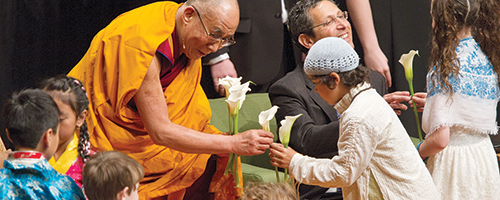A middle-aged Holocaust survivor gazes distantly at the camera as she recalls being herded into cattle trains and then, without realizing what she was doing, handing over her baby to Nazi officers. But at the time, she only experienced handing over a “bundle,” not a baby.
Healing trauma with conversation
A middle-aged Holocaust survivor gazes distantly at the camera as she recalls being herded into cattle trains and then, without realizing what she was doing, handing over her baby to Nazi officers. But at the time, she only experienced handing over a “bundle,” not a baby.
“I think I was numb. There was no baby, I was alone with myself. Now all my life I’m alone,” the woman says to her interviewer, psychoanalyst Dr. Dori Laub.
Laub projected this and two other Holocaust survivor video testimonies in the darkened Multicultural Center at Portland State on Thursday evening, during a lecture called “Re-establishing the Internal ‘Thou’ in ‘Testimony of Trauma.’”
The event was part of the Holocaust and Genocide Studies Project series at the Portland Center for Public Humanities and was co-sponsored by the Oregon Holocaust Resource Center.
Born in 1937 in Czernowitz, Romania, and a survivor of the Holocaust himself, Laub is an associate clinical professor of psychiatry at Yale University and a practicing psychoanalyst in New Haven, Conn.
“On one hand, they remember too much; on the other hand, they remember too little,” Laub said of Holocaust survivors.
Founder of the Fortunoff Video Archive for Holocaust Testimonies at Yale, Laub has centered his scholarship on the concept that victims of extreme trauma do not fully know or internalize the details of the trauma they experienced. Extreme trauma, Laub has found, obliterates the “internal thou,” the inner self with which a person converses in order to make sense of happenings.
In another video testimony screened during the lecture, a man was rendered speechless when asked by Laub to revisit a particularly painful memory. Only after his fourth attempt at speaking did a narrative begin to emerge.
“Being listened to in interviews brings together disjointed memories,” he said. “But [the survivor] must begin with not knowing what she knows.”
Testimony revives this inner dialogue with an “internal thou,” Laub explained to an attentive, sometimes emotional, audience that consisted of students, professors and community members.
“Symbols are needed to communicate with oneself. For Holocaust survivors, there was no internal symbolization,” he said.
Laub began videotaping Holocaust testimonies in 1979 and has since participated in more than 120 sessions.
“Every experience of survival, of retelling, has creative aspects in it,” said Laub, who spoke of artistic representation of genocide as a useful vessel for the process of testimony. Retellings like Maus, a graphic novel that depicts the author’s process of drawing his father’s Holocaust testimony as a world where Jews are mice and Germans are cats, using symbols and narrative to retell the untellable, Laub explained.
Laub often guides survivors away from memorized retellings—often used for self-protection—and into authentic testimony. He said narratives often lose their color when repeated.
“There has to be discovery. There has to be something creative, new, interactive, for it to really make a difference,” he said. “We never called it therapy, but it had a therapeutic effect.”
The process of filming testimonies brought in a third witness to the interviews—the camera.
“I tend to forget there’s a camera,” Laub said, “until you see the cameraman
crying.”






